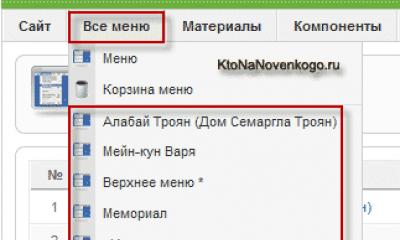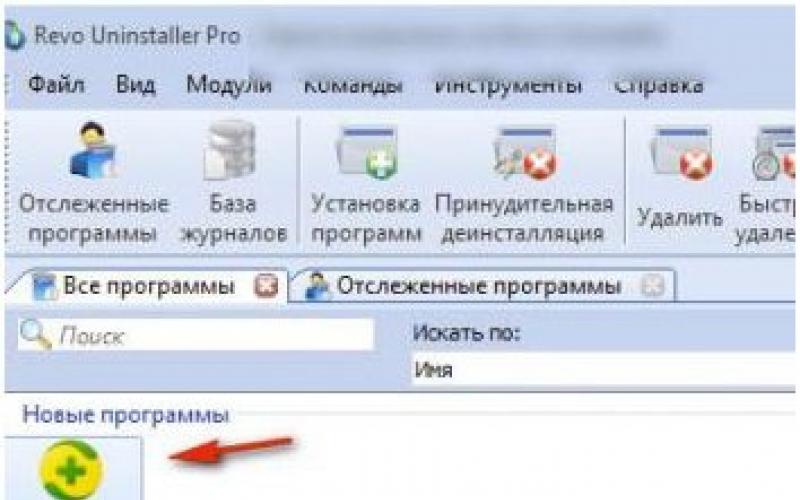Passwords are exactly what you can’t imagine without modern computer, regardless of the operating system. And the further you go, the more passwords there are - new sites, forums, and sometimes just programs. It is almost impossible to remember the abundance of all this information. There are several solutions to this problem. The first is to use one password for all sites/forums/programs when registering. However, this solution has a very big drawback - security. Therefore, I cannot recommend this solution to anyone.
The second, more correct solution involves using different passwords for all sites and storing them in one text file or in a notebook. However, in this case too, safety is not strong point– an attacker just needs to look through your notebook and that’s it – he is almost the rightful owner of your life.
The third solution, the most convenient to use and does not put your data at risk, is to use different passwords on all sites and store information about them on your computer in encrypted form. This is exactly the path that developers from Agile Web Solutions took when creating the 1Password application.
The 1Password program has versions for Mac OS, iOS, Windows and Android, however, regardless of the platform, it pleases with a well-thought-out interface that even a beginner will not get confused in, as well as the fact that the application interface is separately drawn for each platform. There is one more feature that is common to all versions of the program - to access the application database, you must enter one password (thanks to which, in fact, the program got its name).
However, in addition to passwords, 1Password is capable of storing data about software licenses, secret notes, credit card data and even passports - thus, the application from Agile Web Solutions is a universal repository of confidential data. But first things first.
Storing Website Passwords

For each Internet page, the address is saved (which eliminates the possibility of data being used by phishing sites), login and password, as well as a screenshot. You can also assign tags and notes and attach a file. The latter, in my opinion, is overkill, but I think it is necessary for some users. Passwords stored in 1Password can be accessed and subsequently used in two ways. The first, more suitable for viewing various database items and editing them - in the main program window, select the corresponding item on the left side of the window. At the same time, you see both a screenshot of the page and the date the entry was created/last edited. The second way to access password database entries is ideal when surfing the Internet - thanks to the extension built into your browser (supported by Safari, Firefox, Canino, OmniWeb, WebKit, NetNewsWire, DEVONagent, Fluid, Flock, iCab and Chrome), you don’t need every run the program once in order to log into a particular site. Just click on the button with the “1P” logo on the toolbar and select “Fill out and send %NAME%” (or choose the same thing for context menu pages) – and that’s it! And, of course, the password entered into the program database from Safari can then be used, for example, in Firefox.
By the way, when using modifier keys, the first line in this menu changes, and along with it the action being performed:
– with the ALT/Option key held down:

– with the Shift key held down:

– with ALT/Option+Shift keys held down:

Well, if the site’s authorization data is not yet in the database of the program from Agile, then after filling out the “login” and “password” fields you will be asked to save them in 1Password - again, thanks to the extension for the browser you are using.
In addition to storing passwords for Internet pages, the program allows you to create entries for saving login-password combinations, for example, from iTunes or ICQ/AOL. When creating a new entry, you are prompted to select the type of entry to be created. The number of fields also depends on what type of record is selected - for a Generic Account there are only two fields (Login and Password), and for an E-mail account there are many more (you can select a POP/IMAP account, specify POP/IMAP-SMTP -servers, etc.)

In addition to its main purpose - storing passwords, the program can also be used to create secure notes, store program licenses (very convenient), business card data, passports, driver's licenses - for all this, 1Password has its own section and template with its own fields. Business card data can be used when filling out the appropriate fields in online stores directly from the browser. It is also possible to create “Personalities” - special templates with your personal data (Last Name, First Name, Nickname, Date of Birth, etc.), which can be used when registering on sites, thereby speeding up the registration process.

Undoubtedly, an important part of the program is the secure password generator (can be called directly from the browser; has very flexible settings):

One of the main functions of iOS devices is the Safari browser, which allows you to fully work with Internet pages. And if so, then on both iPhone and iPad there is a need to access the 1Password database. Fortunately, the developers at Agile Web Solutions have programs for both types of devices (and even Android) in their portfolio.
The first time you launch the iOS app, you will be prompted to set a login password and master password. A master password can be assigned to particularly important data, e.g. credit cards.

The iPhone program has all the same templates for creating new entries as the desktop application:

The iPad app boasts the same thing, plus a more interesting interface:

Programs for iOS have functionality almost identical to the application for Mac OS. The only major difference is that 1Password is mobile devices ah does not integrate into the browser. This somewhat reduces the usability of the application, however, it should be noted that this is not the fault of the developers of Agile Web Solutions - Safari Mobile on at the moment Doesn't support extensions at all. In order to somehow compensate for this small drawback, 1Password has a built-in browser that already has autofill from the application database:

Syncing 1Password for iOS with the desktop app can be done via WiFi, or, more conveniently, via Dropbox.

1Password Anywhere
One of the interesting features of 1Password 3 is a special database that can be used to view saved passwords using any browser without using the program itself, such as a flash drive. And when using Dropbox synchronization - via the Internet, from anywhere in the world. This is very convenient, for example on the road. This is achieved using several HTML files (an entire mini-site), the main one is called 1Password.html and is located in the 1Password.agilekeychain folder.
1Password Anywhere, launched in a browser, only allows you to view existing entries - you cannot create new ones or make changes to existing ones.
When using Dropbox synchronization, you do not have to worry about the security of your data - it is under reliable protection. First, your Dropbox password. And secondly, the 1Password master password. Without a master password, you won’t be able to view a single entry, as they are all stored in encrypted form.
Based on all that has been written above, I can say with confidence that the program really deserves your attention, since it is one of the best of its kind (if not the best), and in general it is practically irreplaceable in the computer industry.
1Password for Mac
Name: 1Password for Mac
Developer: Agile Web Solutions
Price: 39.99$
Link: official website
1Password for iPhone/iPod Touch
Name: 1Password for iPhone/iPod Touch
Developer: Agile Web Solutions
Price: 9.99$
Link: App Store
1Password for iPad
Name: 1Password for iPad
Developer: Agile Web Solutions
Price: 9.99$
Link: App Store
1Password for iPhone/iPod Touch/iPad
Name: 1Password for iPhone/iPod Touch/iPad
Developer: Agile Web Solutions
Price: 14.99$
Link:
Hello everyone, dear users of mobile devices based on the AppleiOS operating system - iPhone or iPad. In today's article I will tell you about an excellent password manager for iPhone and iPad. We all actively use the Internet, social networks, we have email and other useful accounts.
For each profile, in each account you have a login and passwords. This is the simplest principle of safety. But where to store all these passwords? How to organize the storage of your passwords as conveniently and as securely as possible. The answer is simple - passwords can and even should be stored on your iPhone or iPad.
I will talk about storing passwords using the 1Password program as an example. You can download this application to your iPhone or iPad using this link -. So, let's see how to use the 1Password program.
1Password
When you first launch the program, you will be offered a choice: create a new safe or synchronize an existing safe on another device. If you have not used the program before, then choose to create a new safe.
Next, you will be prompted to set a master password. It is needed to prevent unauthorized access to your safe. I suggest you think about creating a master password and make it as varied as possible (numbers, letters) and as difficult as possible to guess. After you set the master password, you need to set the security settings, fortunately this is done very simply.
After you complete all the above operations, you will be taken to the main window of the 1Password program.
Here you are asked to choose one of three data options:
- Logins– using this tool you can easily store data from your accounts.
- Credit cards– using this tool you can easily store and not forget the details of your credit and debit plastic cards.
- Data– this function is needed to store various data, for example, your passport data or your driver’s license.
Let's move on to adding data in the format of login and password.
In the main program window, select the plus sign. It is in the upper right corner.

Select a service, tap on it and in the window that opens, write the login of the selected service.

Other options

Now let's quickly go through the other features of the program. Add credit card details:
- Return to the main menu of the program and click the plus sign in the upper right corner.
- Select credit card.
- Next, you need to enter all the necessary data, after that click the done button in the upper right corner. The card details will be saved successfully.
In a similar way, you can add other data, such as a secure note or other data, such as your document data. Agree, it’s convenient - everything is stored in one place and reliably protected.
Life is much easier for users with iCloud Keychain - they can . In applications, the entire process happens automatically. Because Face ID scans automatically, you don't even have to tap anything. Now users with the 1Password and LastPass apps can do the same.
New APIs are available that allow you to connect LastPass to the standard password autofill system. You can automatically insert logins and passwords from saved sites. However, this only applies to autofill passwords. If this is your first time logging into a new site, you will be prompted to save your LastPass login information. In addition, in iOS 12 you can use two password managers at the same time.
The process will be the same for both applications. For instructions we will use LastPass.
- Download: LastPass (free)
- Download: 1Password (free)
How to add third-party managers to SettingsiOS 12
First, you need to make sure that your password manager supports autofill. LastPass and 1Password have already been updated for iOS 12, so we recommend choosing them.
Step 1: Open Settings -> Passwords and accounts -> Autofill passwords and enable the function.
Step 2: Check the box next to the LastPass (or other password manager) option. LastPass will prompt you to disable iCloud Keychain, but you don't have to.
That's it, LastPass password autofill was enabled. Now open the LastPass app, sign up for it, and save all your data for the sites you use most often. To add data, click the "+" icon.
How to autofill passwords viaLastPass or 1Password
Step 1: Open an app or site for which you've already saved data in LastPass (or another password manager).

Step 2: Click on the login field and a suggestion will appear above the keyboard with data auto-fill.
Step 3: If the data does not appear, click on the key icon. The LastPass app will open with a list of saved logins. You can select the one you need from there, and the data will be filled in automatically.

That's all. Now you can easily autofill passwords using LastPass or 1Password!
He told me how to get the most out of the 1Password password manager for Mac.
I first became acquainted with the 1Password password manager immediately after purchase first Mac. Since then, it has become such an important and familiar part of working at the computer that I don’t even look towards analogues. I think every 1Password user does this. And only beginners have a question about what it is better than competitors represented by mSecure, OneSafe.
My answer is simple: over the 8 years of my work with 1P, I have become convinced that this program works flawlessly and is constantly evolving.. This is a cult password manager that less popular and cheap solutions are equal to. And it is unlikely that anything will change in the foreseeable future. And while this continues, it’s unlikely that anything will force me to migrate to another application. Whatever one may say, storing passwords is a sensitive topic.
This article will talk about its non-obvious functions that will make your work with passwords faster and more convenient.
Smart bookmarks and automatic login
How do you login to your sites? As soon as possible in the usual way:
- Open the required resource;
- Click on the 1Password icon;
- select an entry to fill in your login and password;
It turns out that filling in passwords can be automated so that your login and password will be entered immediately when you click on the bookmark (if 1Password mini is locked, a window will appear asking you to enter your password). That is, all these three points are combined into one action.
 Drag the link from 1P to your browser bookmarks
Drag the link from 1P to your browser bookmarks To add a smart bookmark, you need to go to 1Password, select an entry and drag it to the Safari bookmarks bar. The bookmark will be the link in the “website” field.
Automatic login via SSH
Instead of simply storing your password in 1P, you can make a smart link from SSH, which, when clicked, will automatically launch Terminal for you and send a login command. All you have to do is enter your SSH password. Simply put, you don’t need to separately launch Terminal and type something like ssh [email protected] .
To do this, create new entry type Login and put it as a web link ssh://user@hostname.

Of course, for those who spend half the working day in the Terminal, this doesn’t make them feel any colder. But for “hackers” like me, the trick is very useful.
Shortcuts
Cmd / - this combination will automatically fill out the login form for the current site, so there is no need to click on the 1P icon in the browser again. If there is only one login for this site, then autofill will occur automatically. If there are several, a list of available logins will appear that you can navigate with the cursor.
Cmd Shift C - copies the password of the current entry. Very convenient in 1Password mini and browser extension (which are essentially the same thing). There is no need to go into the record separately and look for the password field to copy it.
Opt - if you hold down this key, then all fields with an asterisk will become visible. Convenient if you need to look up some short password, say, CVV from a card.
One-time passwords
A one-time password is a short digital code that must be entered after entering the main password. This code is often referred to as “two-step authentication.” This code is updated every 30 seconds and is generated within 1Password itself.
 This is what a one-time password looks like
This is what a one-time password looks like If the site has the ability to use two-step authorization, then 1Password will remind you of this.
 1Password reminds me to enable two-step verification on Reddit
1Password reminds me to enable two-step verification on Reddit In conclusion
If you clean out your storage and master a few basic shortcuts, you can easily buy yourself a chocolate medal. Well, if it has already been eaten, then be sure to spend time reviewing your passwords (the wizard is in the sidebar) and update the most important ones. Well, for me personally, one-time passwords became the killer features. Be sure to use them.
KeePass Password Safe program — free program open source (TrueCrypt), which stores your passwords in a secure database, distributed under the GPL license. The utility is not created exclusively for the operating room Windows systems, but also for Mac OS X, BSD, Linux and other Linux-like systems, by Dominik Reichl (in German). KeePass uses Advanced Encryption Standard and Twofish algorithms for secure password encryption their own databases (banks also use them). The password manager is a portable program and does not need to be installed, it is Russified. Export is available in formats such as HTML, TXT, CSV and XML, and import is possible from many other formats.
Windows versions of KeePass: Professional Edition - contains many functions and requires installation of the .NET Framework and Classic Edition - a simpler version.
How to use Keepass
Before you start using the Keepass program, you need to install, configure and Russify the password generator.
Installation. Need to download and unpack latest version from the official website. We recommend the portable version with installation on a flash drive.

Russifier. Download the Russian version of the language file program from here and then copy “Russian.lngx” to the root directory of the program. After which you need to run KeePass → View → Change Language → Select Language → and Restart KeePass.

It is also advisable to configure the program to start at system startup.
Service → Settings → Integration → Launch KeePass at system startup.
And let’s make it always open in a collapsed and locked state:
Service → Settings → Advanced → Launch in minimized and locked state.
It is very convenient that Kipas has AutoType by default, by pressing the key combination Ctrl+Alt+A (USERNAME) (TAB) (PASSWORD) (ENTER).
Instructions: how to create a new password database
KeePass will save all passwords in the created database. So, to do this you need to create a database -> select “File - New...” in the main menu or click the left icon on the all toolbar. A window will pop up asking you to enter the master password or disk key. Your password database will be encrypted with the password you enter here. Then press .
You are now in the main window. On the left are groups of passwords, and on the right are entries about passwords.
Now you can save your first password in this password database called KeePass! Click right click mouse in the right window and then select “Add entry...”. The following window will pop up. In it you can edit the entry: enter an invented name for it, a custom name, link, password, etc. When you finish filling it out, click .

You can now see your newly created entry in the password list on the right side.
How to use the recording
You now have the created entry in your password list. What can you do with it?
You have several different options. For example, you can make a copy of the username from the Windows clipboard entry. Once you have copied it, you can send it and use it in any other program. It works, and copying passwords.
Plugins
KeePass has such an architecture, whose functionality is extended by third-party modules, so-called plugins. The most popular plugins can be downloaded from home page KeePass (available to export or import from various data formats, create database backups, automation, password manager integration with browsers, etc.). You also need to be aware that plugins can jeopardize the security of the KeePass program, since they are developed by independent programmers and have access to the KeePass database. It encrypts links, logins and notes.
Advantages
- Very high security. In addition to technical details such as the caching and encryption algorithms used, support for two-factor authentication is also important to us.
- Open source. There is an opinion among developers and programmers that reliable and good cryptographic software simply cannot be closed. KeePass is an OSI Certified program.
- Full cross-platform including everything operating systems for mobile devices, excluding Symbian and WebOS.
- What is amazing is that a program of this level, power and functionality is free.
- A huge plus is portability. Kipas does not need installation, it can easily work from a flash drive, it does not create or store anything in the system.
- There is no need to install according to strict instructions. Two download formats are available: installer and zip file. The service has a built-in password generator.
KeePass analogs
KeePassX— password storage program. It is a cross-platform KeePass port.
LastPass- completely free, also to store the password, created by LastPass. It is developed in the form of plugins for Google Chrome(Chromium), Internet Explorer, Mozilla Firefox, Apple Safari and Opera. There is also a LastPass bookmarklet for other browsers.
RoboForm— for auto-filling various forms on websites. Distributed under Shareware license.
Keychain(translated from Russian: Keychain) is a function (technology) thanks to which, in one place on Mac OS X, the user’s personal data is stored in an encrypted and secure form: logins and passwords. And the last ones Password Safe, iMacros.







